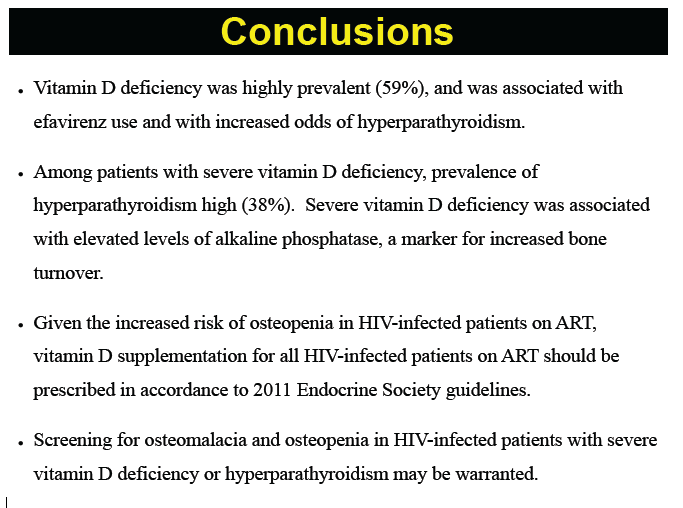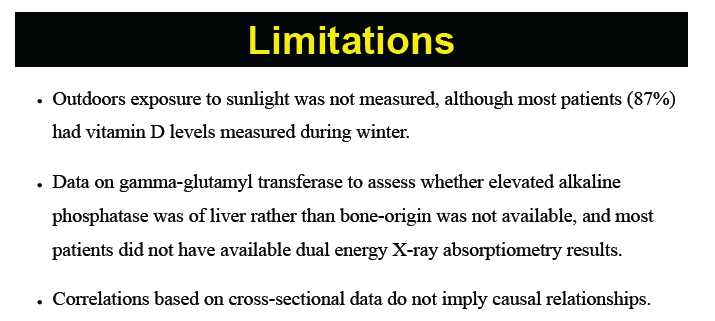 |
 |
 |
| |
Hyperparathyroidism Associated with Vitamin D Deficiency in HIV-Infected Adults
|
| |
| |
Reported by Jules Levin
CROI 2012 March 5-8 Seattle WA
Candice K. Kwan1, 2, Benjamin Eckhardt1, 2, Jonathan Baghdadi1,2, Judith A. Aberg1, 2
1Bellevue Hospital Center, New York, NY 2New York University School of Medicine, New York, NY

ABSTRACT
Background: Although recent studies report a high prevalence of vitamin D deficiency in HIV-infected adults similar to that in the general population, metabolic complications of vitamin D deficiency may be worsened with HIV infection and remain to be better characterized. We conducted a retrospective cross-sectional cohort study to determine prevalence of vitamin D deficiency and hyperparathyroidism among HIV-infected patients attending a clinic in New York City, and evaluated use of combination antiretroviral therapy (ART) as a risk factor for vitamin D deficiency and hyperparathyroidism.
Methods: The study included HIV-infected persons >18 years, who received routine HIV care at Bellevue Virology Clinic from October 2009--March 2010, and who had serum 25(OH)-vitamin D and parathyroid hormone (PTH) measured. Vitamin D deficiency was defined as 25(OH)-vitamin D < 20 ng/ml, vitamin D insufficiency as 20 to <30 ng/ml. Hyperparathyroidism was defined as PTH > 65 pg/mL. We compared proportions of patients with and without vitamin D deficiency who had hyperparathyroidism using chi-square testing, and logistic regression to assess for factors associated with vitamin D deficiency and hyperparathyroidism.
Results: Among 463 HIV-infected patients, prevalence of vitamin D deficiency was 59%. Among 405 patients who had serum PTH measured, prevalence of hyperparathyroidism was 30% (73/241) among patients with vitamin D deficiency, 23% (23/99) among those with vitamin D insufficiency, and 12% (8/65) among those with sufficient vitamin D levels. Vitamin D deficiency was associated with
increased odds of hyperparathyroidism (OR 1.86, 95% CI: 1.16, 3.01). Current use of efavirenz (EFV) was associated with vitamin D deficiency (aOR 3.06, 95% CI: 1.32-7.13) after adjusting for age, black race, weight, use of vitamin supplements, CD4 cell count, and viral load. Current use of protease inhibitor (PI) (OR 0.51, 95% CI: 0.30-0.88) was associated with decreased odds of vitamin D
deficiency in univariate but not multivariate analysis. We did not detect a statistical difference in rates of hyperparathyroidism among patients not on ART, on EFV-based ART, or on PI-based ART.
Conclusions: Hyperparathyroidism was associated with vitamin D deficiency in our clinic population of HIV-infected patients. Given the increased risk of osteopenia with ART use, HIV-infected patients on ART who have vitamin D deficiency and hyperparathyroidism may benefit from screening for osteomalacia and osteopenia.








|
| |
|
 |
 |
|
|